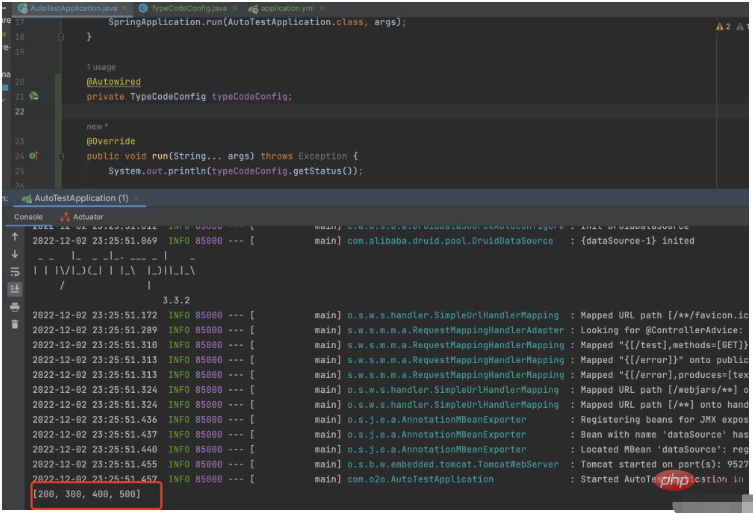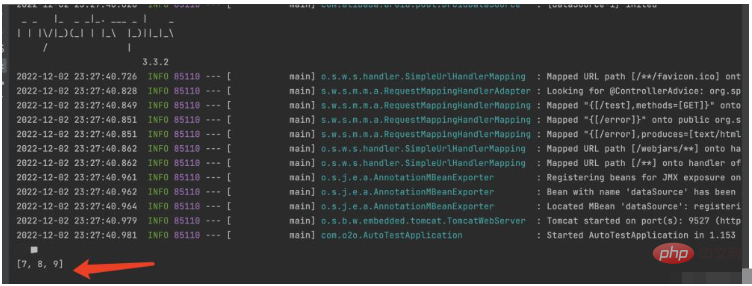 Java
Java
 javaLernprogramm
javaLernprogramm
 Wie liest Springboot Listen, Arrays, Kartensammlungen und Objekte in YML-Dateien?
Wie liest Springboot Listen, Arrays, Kartensammlungen und Objekte in YML-Dateien?
Wie liest Springboot Listen, Arrays, Kartensammlungen und Objekte in YML-Dateien?
May 11, 2023 am 10:46 AMapplication.yml definiert die Listensammlung
Die erste Möglichkeit besteht darin, die Annotation @ConfigurationProperties zu verwenden, um alle Werte der Listensammlung abzurufen@ConfigurationProperties注解获取list集合的所有值
type:
code:
status:
- 200
- 300
- 400
- 500编写配置文件对应的实体类,这里需要注意的是,定义list集合,先定义一个配置类Bean,然后使用注解@ConfigurationProperties注解来获取list集合值,这里给大家讲解下相关注解的作用
@Component 将实体类交给Spring管理
@ConfigurationProperties(prefix = “type.code”) 读取yml文件中的list
@Data 自动生成getter和setter方法
如下图所示
package com.o2o.data;
import lombok.Data;
import org.springframework.boot.context.properties.ConfigurationProperties;
import org.springframework.context.annotation.Configuration;
import java.util.List;
@Component
@ConfigurationProperties(prefix = "type.code") // 配置文件的前缀
@Data
public class TypeCodeConfig {
private List<String> status;
public void setStatus(List<String> status){
this.status = status;
}
public List<String> getStatus(){
return status;
}
}然后在要使用的地方自动注入,我是直接在启动类中读取这个list,需要注意,使用yml中配置的list需要先将对象注入,然后通过get方法读取配置文件中的的值。
@Autowired private TypeCodeConfig typeCodeConfig; 使用注解将对象注入
System.out.println(typeCodeConfig.getStatus()); 调用getter方法读取值
package com.o2o;
import com.o2o.data.TypeCodeConfig;
import org.mybatis.spring.annotation.MapperScan;
import org.springframework.beans.factory.annotation.Autowired;
import org.springframework.boot.CommandLineRunner;
import org.springframework.boot.SpringApplication;
import org.springframework.boot.autoconfigure.SpringBootApplication;
import org.springframework.boot.autoconfigure.jdbc.DataSourceAutoConfiguration;
@SpringBootApplication(exclude = {DataSourceAutoConfiguration.class})
@MapperScan("com.o2o.mapper")
public class AutoTestApplication implements CommandLineRunner {
public static void main(String[] args) {
SpringApplication.run(AutoTestApplication.class, args);
}
@Autowired
private TypeCodeConfig typeCodeConfig;
@Override
public void run(String... args) throws Exception {
System.out.println(typeCodeConfig.getStatus());启动springboot我们已经从控制台成功读取到yml文件中list集合的所有值了

第二种方式使用@value注解获取list集合的所有值
yml文件配置如下
student:
ids:
- 7
- 8
- 9然后创建一个实体类
@Data
public class Student {
@Value("${student.ids}")
private List<Integer> ids;
}再新建一个对list属性的配置类
@Component
@ConfigurationProperties(prefix = "student")
@Data
public class TypeCodeConfig {
private List<Integer> ids;
public void setIds(List<Integer> ids) {
this.ids = ids;
}
public List<Integer> getIds(){
return ids;
}在启动类中注入
@SpringBootApplication(exclude = {DataSourceAutoConfiguration.class})
@MapperScan("com.o2o.mapper")
public class AutoTestApplication implements CommandLineRunner {
public static void main(String[] args) {
SpringApplication.run(AutoTestApplication.class, args);
}
@Autowired
private TypeCodeConfig typeCodeConfig;
@Override
public void run(String... args) throws Exception {
System.out.println(typeCodeConfig.getIds());
}启动springboot我们已经从控制台成功读取到yml文件中list集合的所有值了

application.yml定义数组类型
yml配置文件如下图所示
dataSync: enable: true type: - "1" - "2" - "3"
通过@value注解获取数组值
@Value("${dataSync.enable.type}")
private String[] type;也可以通过创建配置类bean,使用@ConfigurationProperties注解
@Data
@Component
@ConfigurationProperties(prefix = "dataSync.enable") // 配置 文件的前缀
public class InterceptorPathBean
{
private String[] type;
}Bean und verwenden Sie dann die Annotation @ConfigurationProperties, um den Listensammlungswert zu erhalten. Hier erklären wir die Rolle der relevanten Annotationen
@Component Übergibt die Entitätsklasse an Spring Management@ConfigurationProperties(prefix = „type.code“) Liest die Liste in der YML-Datei
@Data generiert automatisch Getter- und Setter-Methoden
Wie in der Abbildung unten gezeigt
interceptorconfig:
path:
maps:
name: 小明
age: 24Dann wird es automatisch dort eingefügt, wo es verwendet werden soll. Ich habe diese Liste direkt in der Startup-Klasse gelesen. Beachten Sie, dass Sie bei Verwendung der in yml konfigurierten Liste zuerst das Objekt einfügen und dann den Wert darin lesen müssen Konfigurationsdatei über die get-Methode.
@Autowired private TypeCodeConfig typeCodeConfig; Annotationen verwenden, um Objekte in
System.out.println(typeCodeConfig.getStatus()) einzufügen ; Rufen Sie die Getter-Methode auf, um den Wert zu lesen.
@Data
@Component
@ConfigurationProperties(prefix = "interceptorconfig.path") // 配置 文件的前缀
public class InterceptorPathBean
{
private Map<String , String> maps;
}@value und ruft alle Werte der Listensammlung ab. Die Konfiguration der YML-Datei lautet wie folgt: student: id: 1 name: Bruce gender: male
students:
- id: 1
name: Bruce
gender: male
- id: 2
name: ...
...
Das obige ist der detaillierte Inhalt vonWie liest Springboot Listen, Arrays, Kartensammlungen und Objekte in YML-Dateien?. Für weitere Informationen folgen Sie bitte anderen verwandten Artikeln auf der PHP chinesischen Website!

Heißer Artikel

Hot-Tools-Tags

Heißer Artikel

Heiße Artikel -Tags

Notepad++7.3.1
Einfach zu bedienender und kostenloser Code-Editor

SublimeText3 chinesische Version
Chinesische Version, sehr einfach zu bedienen

Senden Sie Studio 13.0.1
Leistungsstarke integrierte PHP-Entwicklungsumgebung

Dreamweaver CS6
Visuelle Webentwicklungstools

SublimeText3 Mac-Version
Codebearbeitungssoftware auf Gottesniveau (SublimeText3)

Heiße Themen
 So implementieren Sie verteilte Sperren mit Redis in SpringBoot
Jun 03, 2023 am 08:16 AM
So implementieren Sie verteilte Sperren mit Redis in SpringBoot
Jun 03, 2023 am 08:16 AM
So implementieren Sie verteilte Sperren mit Redis in SpringBoot
 Vergleich und Differenzanalyse zwischen SpringBoot und SpringMVC
Dec 29, 2023 am 11:02 AM
Vergleich und Differenzanalyse zwischen SpringBoot und SpringMVC
Dec 29, 2023 am 11:02 AM
Vergleich und Differenzanalyse zwischen SpringBoot und SpringMVC
 So lösen Sie das Problem, dass Springboot nach dem Einlesen in ein JAR-Paket nicht auf die Datei zugreifen kann
Jun 03, 2023 pm 04:38 PM
So lösen Sie das Problem, dass Springboot nach dem Einlesen in ein JAR-Paket nicht auf die Datei zugreifen kann
Jun 03, 2023 pm 04:38 PM
So lösen Sie das Problem, dass Springboot nach dem Einlesen in ein JAR-Paket nicht auf die Datei zugreifen kann
 Wie SpringBoot Redis anpasst, um die Cache-Serialisierung zu implementieren
Jun 03, 2023 am 11:32 AM
Wie SpringBoot Redis anpasst, um die Cache-Serialisierung zu implementieren
Jun 03, 2023 am 11:32 AM
Wie SpringBoot Redis anpasst, um die Cache-Serialisierung zu implementieren
 So implementieren Sie Springboot+Mybatis-plus, ohne SQL-Anweisungen zum Hinzufügen mehrerer Tabellen zu verwenden
Jun 02, 2023 am 11:07 AM
So implementieren Sie Springboot+Mybatis-plus, ohne SQL-Anweisungen zum Hinzufügen mehrerer Tabellen zu verwenden
Jun 02, 2023 am 11:07 AM
So implementieren Sie Springboot+Mybatis-plus, ohne SQL-Anweisungen zum Hinzufügen mehrerer Tabellen zu verwenden
 So erhalten Sie den Wert in application.yml in Springboot
Jun 03, 2023 pm 06:43 PM
So erhalten Sie den Wert in application.yml in Springboot
Jun 03, 2023 pm 06:43 PM
So erhalten Sie den Wert in application.yml in Springboot
 Praktisches Tutorial zur SpringBoot+Dubbo+Nacos-Entwicklung
Aug 15, 2023 pm 04:49 PM
Praktisches Tutorial zur SpringBoot+Dubbo+Nacos-Entwicklung
Aug 15, 2023 pm 04:49 PM
Praktisches Tutorial zur SpringBoot+Dubbo+Nacos-Entwicklung
 So erstellen Sie ein SpringBoot+MyBatisPlus-Schnellentwicklungsgerüst
Jun 03, 2023 am 09:28 AM
So erstellen Sie ein SpringBoot+MyBatisPlus-Schnellentwicklungsgerüst
Jun 03, 2023 am 09:28 AM
So erstellen Sie ein SpringBoot+MyBatisPlus-Schnellentwicklungsgerüst






